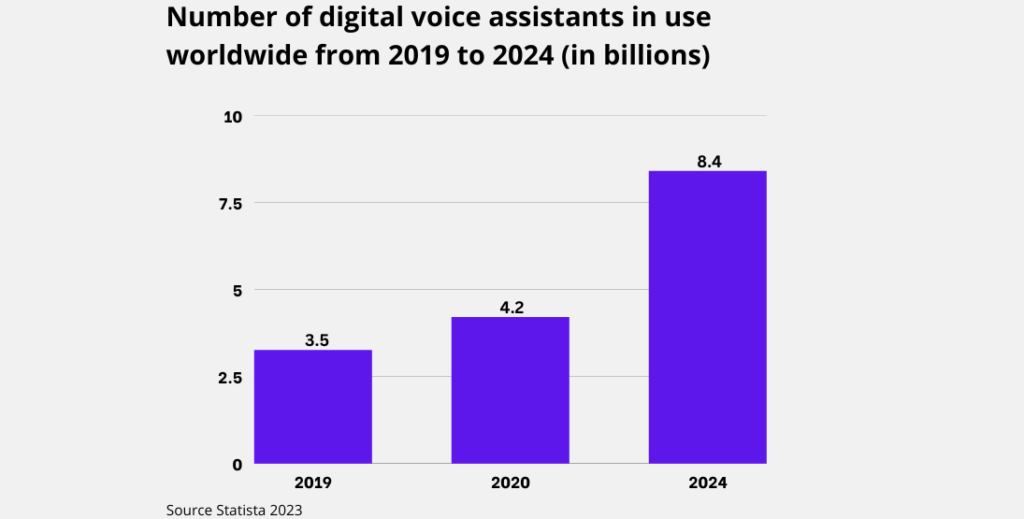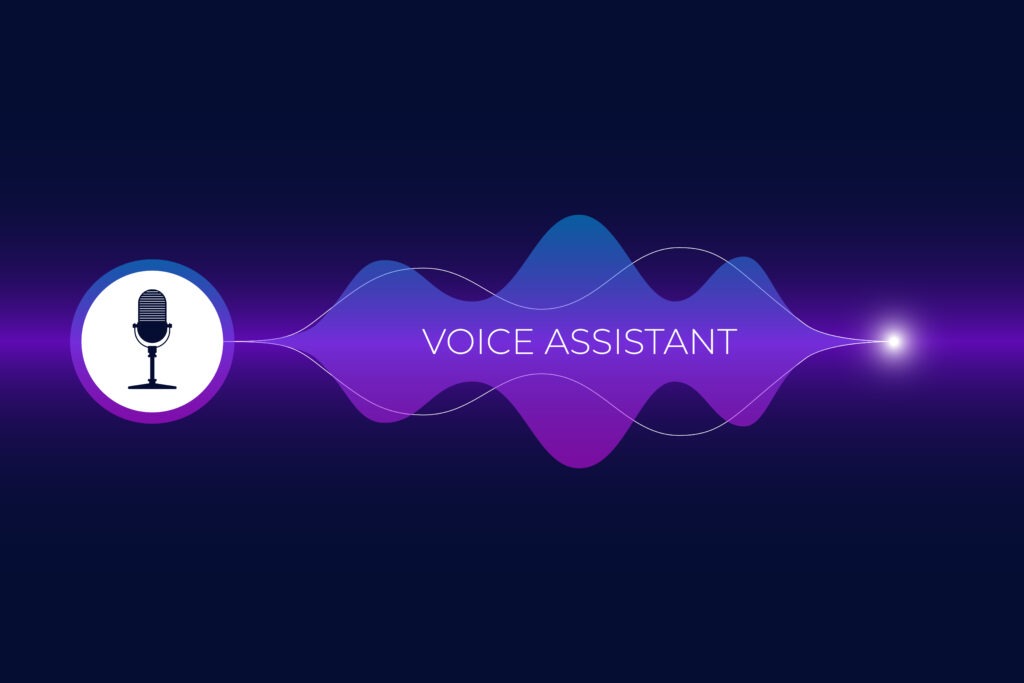Voice search is a technology that allows users to search the Internet by verbally typing search queries into a device instead of typing them. This technology uses advanced speech recognition to understand spoken queries and return results. It is most commonly used in smartphones, smart speakers, and various voice assistants such as Google Assistant, Siri, and Amazon Alexa.

At the core of voice search SEO is optimizing digital content for the conversational and natural language used in voice queries.
This blog focuses on providing businesses with practical advice on how to optimize their online presence for voice search engine optimization. With tips and best practices, we want to help businesses improve their speech recognizer rankings and effectively optimize their websites for the specific needs of voice search. Understanding and implementing these strategies is critical to increasing visibility and engagement in the rapidly evolving speech recognition environment.
What is Voice Search?
Voice SEO, or the practice of optimizing digital content for speech identification queries, is important in today’s technology-driven markets in the B2B, B2C, and e-commerce sectors.
B2B companies should focus on industry-specific, conversational keywords and in-depth content, while B2C companies should optimize for local search and consumer-centric, engaging content. E-commerce platforms should prioritize product-related keywords and optimize language-friendly navigation. What they all have in common is that businesses across industries need mobile optimization, fast load times, and the use of structured data to effectively engage with their audiences in a voice-centric digital world.

The fundamental difference between voice identification and traditional text-based search is how the search query is presented. When searching by voice, users are more likely to use natural, colloquial language. For example, instead of typing “weather in Munich,” a user might ask, “What is the weather in Munich today?” This style of conversation often results in longer, more specific questions.
As voice search technology continues to evolve and become more integrated into daily life, understanding and optimizing speech recognition is becoming increasingly important for businesses and content creators. You need to adapt to the nuances of spoken language and the specific needs of voice search users to ensure that their content is easily discoverable and relevant for this type of investigation.
Why Voice Exploration Matters
Voice search optimization is transforming digital marketing by adapting to evolving consumer behavior. Let’s take a quick look at its impact.
Increased usage: More than 50% of smartphone users now use automatic speech exploration,
showing a trend toward voice-activated devices (PwC).
Impact on local businesses: Users prefer speech recognition for quick tasks, with 71% favoring voice assistants for efficient searches (PwC).
Conversational queries: Voice searches are more conversational and require content that is longer and matches natural language patterns.
Growth of e-commerce: With over 4 billion digital voice assistants in use worldwide, voice examination is now ubiquitous (Statista).
Improved SEO and traffic: Websites optimized for voice search increase traffic and engagement because question-based searches occur faster.

How to do SEO for Voice Exploration
Voice pursuit optimization means tailoring your website and content to the unique nuances of voice queries. These are long extended conversations and are typically asked as questions, making traditional keyword strategies less effective.
Keyword research for voice search requires moving away from traditional SEO techniques and focusing on natural language and question-based content.
Strategies for using SEO voice search
1. Use conversational keywords
For voice pursuit SEO, use natural, conversational keywords relevant to your product or service. Identify these keywords by analyzing customer support records and social media queries. Tools like AnswerThePublic can also help, offering lists of conversational keywords based on your input terms, tailored to your audience’s language. Here’s an example:

2. Prioritize mobile compatibility
Recognizing that most speech recognition is conducted on mobile devices. Given Google’s preference for mobile-first indexing, having a responsive mobile site is vital for high search rankings. Before focusing on voice search SEO, ensure your site is optimized for popular mobile devices to prevent users from abandoning your site for a more mobile-friendly option.
3. Maximize your Google My Business profile
For effective local language detection optimization. Ensure your listing is current, including on other major search engines like Bing. Users often seek quick information like location and opening hours without visiting your website. Provide comprehensive details in your listing, aiding in directing customers to your site or physical location. For instance, if a user inquires about the best video conferencing headset, your My Business listing can offer extensive information, from your website link to business hours.
4. Leverage your FAQ section for content creation
Aligning with the conversational nature of speech recognizer. Unlike traditional SEO focused on specific words or phrases, voice recognition requires content that incorporates complete sentences, often starting with “what,” “where,” “how,” “who,” and “when.” Your existing and future FAQs can be a rich source of these conversational keywords. For instance, a question like ‘What are the benefits of cloud computing to remote workers?’ can inspire new content. Also, consider using queries and comments from your blogs and forums for additional insights.
By adopting these strategies, you can optimize your website for voice search, improve your rankings, and effectively meet the needs of voice search users. This format and content are aimed at blog readers and provide practical advice on conducting keyword research for voice recognition SEO, which is critical to gaining an edge in today’s rapidly evolving digital environment.
Content Optimization for Voice Search
When optimizing for voice recognition, you need to tailor your content to the more conversational, question-based nature of voice queries. Unlike traditional search, voice investigation often involves longer, more specific questions.
Building content for voice search uses natural, conversational language: language detection tends to be more conversational, so create content with a natural, engaging tone that reflects the language people use.
Question-and-answer format: Structure your content to directly answer questions. Voice recognition devices can often ask for quick and concise answers. Try to answer the question directly, ideally in a short paragraph at the beginning of your content.

Voice search SEO tips:
- Target long-tail keywords: Incorporate long-tail keywords that reflect the tone of the voice search conversation. These are often less competitive and more specific.
- Optimize for local searches: Many speech recognizers are location-based, so if your business is local, include local keywords and phrases.
- Use schema markup: Implementing schema markup helps search engines understand the context of your content. This is beneficial for speaker identification queries and improving voice search rankings.
- Focus on featured snippets: Content in featured snippets is more likely to be selected by a voice assistant. Format your content to align with these snippets, such as using bullet points in lists or clear, direct answers to questions.
- Mobile optimization: Most language detection is done on mobile devices, so make sure your website is mobile-friendly.
- Understand user intent: Understand the intent behind voice searches to effectively tailor your content. Are users looking for information, a location, or a specific service?
- Regular content updates: New content is often preferred by both users and search engines, so keep your content current and relevant. Keep it high.
- Test your content: Regularly test how your content performs in speaker recognition and adjust as needed.
Optimizing content for voice search requires a multifaceted approach, from language and structure optimization to a nuanced understanding of how voice search works. By following these tips and best practices, you can effectively improve your website’s visibility and ranking in vocal recognition results, helping more users turn to voice search as they rely on online searches. This will ensure that the content meets your needs.
Technical SEO for Voice Search
While content optimization is an important aspect of vocal search SEO, the technical aspects of search engine optimization play an equally important role. This guide details the technical aspects of SEO for vocal identity, emphasizing the importance of site speed and mobile optimization.
The importance of technical SEO in voice search.
The technical SEO for speech recognition involves tweaking your website’s infrastructure to make it more accessible and responsive to voice search queries. This includes aspects such as site speed, mobile friendliness, and structured data, which are important for improving voice search rankings.
Key technical optimization strategies
Speed Optimization:
- Fast Loading Times: Voice detection favors websites that load quickly. A fast-loading website is likely to rank higher in speaker identification results.
- Use Speed Testing Tools: Tools like Google Pagespeed Insights can help identify areas where your site’s loading speed can be improved.
Mobile Optimization:
- Responsive Design: With most vocal recognition happening on mobile devices, having a responsive design that adjusts to different screen sizes is essential.
- Test Mobile Usability: Regularly check your website’s mobile usability using tools like Google’s mobile-friendly test.
Structured Data Implementation:
- Schema Markup: Implement schema markup to help search engines understand the context and content of your site, which is particularly beneficial for voice search queries.
- Rich Snippets: Structured data can also help your content appear in rich snippets, which are often used in voice detection answers.
Enhancing Voice Search Rankings Through Technical SEO:
- Secure Website (HTTPS): Ensure your site is secure. recognition of speech tends to prioritize websites with HTTPS over HTTP.
- Local SEO Elements: For local businesses, optimizing technical elements like local schema markup and Google My Business listings can improve local voice search visibility.
Best Practices for Technical Optimization:
- Regular Audits: Conduct regular SEO audits to identify and fix technical issues that might hinder voice search performance.
- User Experience Focus: Always prioritize user experience, as search engines increasingly use user engagement metrics as ranking factors.
Technical SEO is a key element in voice search optimization. By focusing on speed, mobile-friendliness, structured data, and other technical aspects, you can significantly improve your website’s compatibility with voice search queries. This multi-layered approach ensures that your website is not only optimized for content but also technically sound to meet the needs of voice search users.
Local SEO and Voice Search
Local SEO and voice SEO go hand in hand, especially in European markets where voice search adoption is rapidly increasing. The relationship between these two aspects of SEO lies in the fact that voice searches are often local in nature. People often use voice search to find nearby businesses, services, and products.
By focusing on these key aspects, businesses can effectively combine local SEO and voice search optimization, ensuring they meet the evolving needs of users who increasingly rely on voice search for local information.
Let’s explore this relationship further using specific examples and improvement strategies in the European context.
Relationship between local SEO and voice SEO:
Conversational queries: Recognition of speech tends to be more conversational and often include phrases like “Located near me” or “Where can I find you?” For example, a user in Munich might ask the voice assistant, “Where’s the closest bakery?”
Local purpose: Customers find businesses with a Google Business Profile (GBP) 2.7x more reputable. They’re also 70% more likely to visit and 50% more likely to purchase from companies with profiles (Semrush).

Strategies for optimizing the European market
- Local language optimization: In the multilingual European market, local language optimization is critical. For example, a company in Brussels needs to optimize voice search for both French and Flemish.
- Cultural relevance: Adapting your content to local cultural aspects improves voice input optimization. For example, including popular local phrases or landmarks in your content can increase your business’s visibility in voice searches.
- Mobile Optimization: With high smartphone usage in Europe, ensuring your website is mobile-friendly is important for voice detection optimization.
- Structured data: Schema markup helps voice search algorithms understand the context of your content, increasing your chances of appearing in speaker identification.
- Local reviews and ratings: Encourage your customers to leave reviews on popular platforms. Positive reviews can improve your rankings in local speaker recognition.
- Optimize Google business card: By improving listing for this trend, ensure all information is current and detailed, including business hours, contact information, and services. Regular updates with new content like promotions or events can enhance visibility. Encourage customer reviews and engage with them.
In the European market, where linguistic and cultural diversity is very important, local and voice SEO strategies need to be precisely tailored to each region’s characteristics. By understanding the symbiotic relationship between local and voice SEO and implementing region-specific optimization, businesses can significantly increase their visibility in voice search results, resulting in increased traffic and customer loyalty will increase. Regularly updating and refining these strategies is key to staying competitive in this dynamic digital environment.
Measuring Voice Search Performance

In the evolving digital marketing environment, it’s important to measure the performance of your voice search optimization efforts. Knowing how to track and analyze your speaker identification performance will help you refine your SEO strategy. Here we outline the most important measurements and tools for monitoring the effectiveness of your speaker recognition optimization.
Key metrics for voice search performance
Voice Search Ranking: Monitor your content’s ranking in voice search results. Generally, higher rankings correlate to more effective voice search optimization.
Voice Detection Traffic: Use analytics tools to track the amount of traffic coming to your website from voice searches.
Keyword Performance: Evaluate which keywords are driving voice search traffic and which keywords are underperforming.
Engagement metrics: View bounce rate, session duration, and page views to understand user engagement with voice search.
Voice Detection SEO Monitoring Tool
To effectively monitor and optimize for speech input SEO, staying updated with the latest tools is crucial. Here are several tools, including some updated and newer options:
- Google Search Console: Essential for tracking website performance in Google’s search results, it offers insights crucial for optimizing voice search SEO.
- 2. Semrush: This tool’s voice search optimization features help track keywords and phrases used in voice queries. It’s particularly good for monitoring position changes and identifying potential voice search queries.
- 3. Answer The Public: Provides visualizations of questions and phrases related to your keywords, which is incredibly useful for voice search optimization, as it focuses on natural language queries.
- 4. Chat meter: Specialized in local SEO and reputation management, it’s instrumental for businesses focusing on optimizing for local voice searches.
- 5. Screaming Frog: A website crawler that helps identify SEO issues on your site, which can impact your voice search rankings.
- 6. Google My Business: Optimizing your listing here is key for local SEO, which directly affects voice search results.
- 7. Bright Local: An all-in-one local SEO tool that helps track local rankings, manage local listings, and monitor online reviews, important for voice search optimization.
- 8. Voice Search Analytics Tools: Some specialized analytics tools are emerging that focus specifically on voice search data, offering insights into how users are interacting with devices using voice commands.
- 9. Google Keyword Planner: In addition to tools that support AdWords (which you should use), you can also view keyword data directly from Google Search. Considering that Google also integrates voice search into its system, this is a great source for keyword research.
Measuring and analyzing voice detection performance is an ongoing process. By focusing on key metrics and using the right tools, you can gain valuable insight into the performance of your voice search SEO efforts.
Challenges of Voice Search Optimization
Voice search optimization is an evolving aspect of search engine optimization that presents unique challenges. Understanding these difficulties and finding ways to deal with them is critical to effectively recognizing speech SEO. Here we outline the main challenges and possible solutions when optimizing voice search.

Key challenges in voice detection SEO:
- Natural language understanding: Voice detection often uses conversational language, which can be more complex to optimize than traditional keyword-based search.
- Localization and personalization: Many voice searches are locally personalized and require a customized SEO approach.
- Limited result visibility: Voice searches often return fewer results than text searches, increasing competition for the top spot.
- Difficulty tracking performance: Tracking language detection traffic and rankings apart from traditional search analytics is difficult.
Strategies to overcome voice search SEO challenges:
Optimize for conversational keywords: Focus on long-tail keywords and natural language phrases that match conversational language patterns.
Improve your local SEO: Boost your local SEO efforts with accurate and comprehensive Google My Business listings, local content, and location-based keywords.
Use schema markup: Implementing schema markup helps search engines understand the context of your content and makes it more relevant to voice queries.
Innovative Tracking Methods: Use advanced SEO tools and techniques to infer voice search traffic, such as monitoring mobile traffic and conversational query performance.
Optimizing for voice search presents unique challenges, but taking strategic approaches such as natural language optimization, focusing on local SEO, and adapting your content for voice search can significantly improve performance. To successfully navigate the complexities of voice recognizing SEO, it’s important to stay up to date with voice search trends and continually refine your strategy.
Conclusion

In summary, navigating the world of recognizing speech SEO is critical for businesses in the digital age. Throughout our discussion, we explored various aspects of voice recognizer optimization, from understanding the unique challenges of voice search optimization to effective content and technical implementation of his SEO strategies.
It aims to help businesses improve their online presence and voice search rankings by focusing on practical tips and insights. As voice search continues to grow, it’s important for businesses to stay informed and adapt to evolving SEO practices to thrive in this dynamic environment.
In the European market, where diversity in language and culture is significant, local and voice SEO strategies must be finely tuned to the specificities of each region. By understanding the symbiotic relationship between local and voice SEO and implementing region-specific optimizations, businesses can significantly improve their visibility in voice search results, leading to increased traffic and customer engagement. Regularly updating and refining these strategies is key to staying competitive in this dynamic digital landscape.


